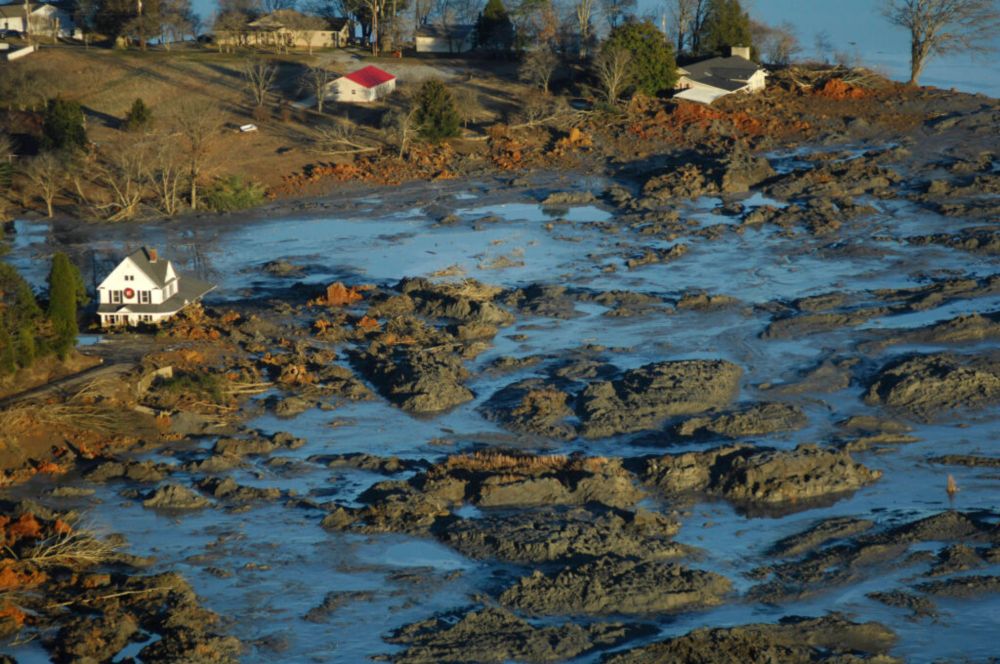What do you call image. Source?
17.11.2025 02:38 — 👍 0 🔁 0 💬 1 📌 0
Please note the ability of Italy in being not green and neither cheaper
25.07.2025 19:02 — 👍 0 🔁 1 💬 0 📌 0
Our paper comparing a number of top down and bottom up methane emission estimates from China and the US is out!
14.06.2025 21:52 — 👍 6 🔁 0 💬 1 📌 0
That's a particularly large difference for advanced cookstoves.
03.06.2025 19:14 — 👍 1 🔁 0 💬 0 📌 0
"for example, an average of 8.9 g/kgfuel (field) compared to 5.2 g/kgfuel (lab) for traditional cookstoves and 4.0 g/kgfuel (field) compared to 1.3 g/kgfuel (lab) for advanced cookstoves"
03.06.2025 19:13 — 👍 1 🔁 0 💬 1 📌 0

Biomass cookstove emissions—a systematic review on aerosol and particle properties of relevance for health, climate, and the environment - IOPscience
Biomass cookstove emissions—a systematic review on aerosol and particle properties of relevance for health, climate, and the environment, García-López, Natxo, Ingabire, Ange Sabine, Bailis, Rob, Eriksson, Axel C, Isaxon, Christina, Boman, Christoffer
Nice review paper on cookstoves. Particularly :
" field studies consistently report particle emission factors (PM2.5) higher than the ... under laboratory conditions"
iopscience.iop.org/article/10.1...
03.06.2025 19:12 — 👍 2 🔁 0 💬 1 📌 0
But it would be similar for
electric generation since the largest part of electricity is coal.
11.04.2025 09:51 — 👍 0 🔁 0 💬 1 📌 0
The most parsimonious solution is to get carbon monitor to use this. Seems like they should
10.04.2025 23:57 — 👍 1 🔁 0 💬 1 📌 0
Gridded emissions out to 2023 are already up at ESGF. note that a user found a discontinuity in the seasonal cycle for 2023. So we are replacing the data to fix that. Other years are not impacted.
09.04.2025 23:19 — 👍 1 🔁 0 💬 0 📌 0
Change in Hydro looks to be about the right magnitude to offset the seasonal change in goal.
Note that renewables are about the same order of magnitude Hydro, and will also have seasonal patterns.
09.04.2025 23:17 — 👍 1 🔁 0 💬 0 📌 0
Yes, we could use that. There is seasonality in latest CEDS, but it’s small and inconsistent from year to year.
I note that the signal you show not that large. That might be overwhelmed by seasonality in atmospheric chemistry and transport.
But still worth improving the emissions, of course.
09.04.2025 23:14 — 👍 0 🔁 0 💬 1 📌 0
I haven’t noticed anything missing from EIA. Any specifics.
08.02.2025 04:29 — 👍 1 🔁 0 💬 0 📌 0
Two new Maryland climate working group reports will help guide the state's energy transition and meet its ambitious climate goals, established by Maryland's Climate Solutions Now Act.
Check out the research, supported by CGS and led by the CGS Maryland Program Dir. @kmkennedy6.bsky.social, below:
05.02.2025 20:50 — 👍 1 🔁 2 💬 1 📌 0
2/2 so it’s really about truth in marketing and accountability - which is not generally present.
The culture tends to perpetuate that the academic route is the only true “success”, and that’s a problem.
That doesn’t excuse the overuse of postdocs as cheap labor with no stable career path.
26.01.2025 16:28 — 👍 5 🔁 0 💬 0 📌 0
1/2 This “leave academia“ or even “leave science” wording is counterproductive.
The system is set up to overproduce postdocs, the incentives for that haven’t changed. So this shouldn’t surprise anyone.
It’s not ness a bad thing if not all are doing research, PhD’s are useful in other places.
26.01.2025 16:25 — 👍 3 🔁 0 💬 0 📌 0
Sorry to hear this very sad news.
25.01.2025 11:39 — 👍 1 🔁 0 💬 0 📌 0
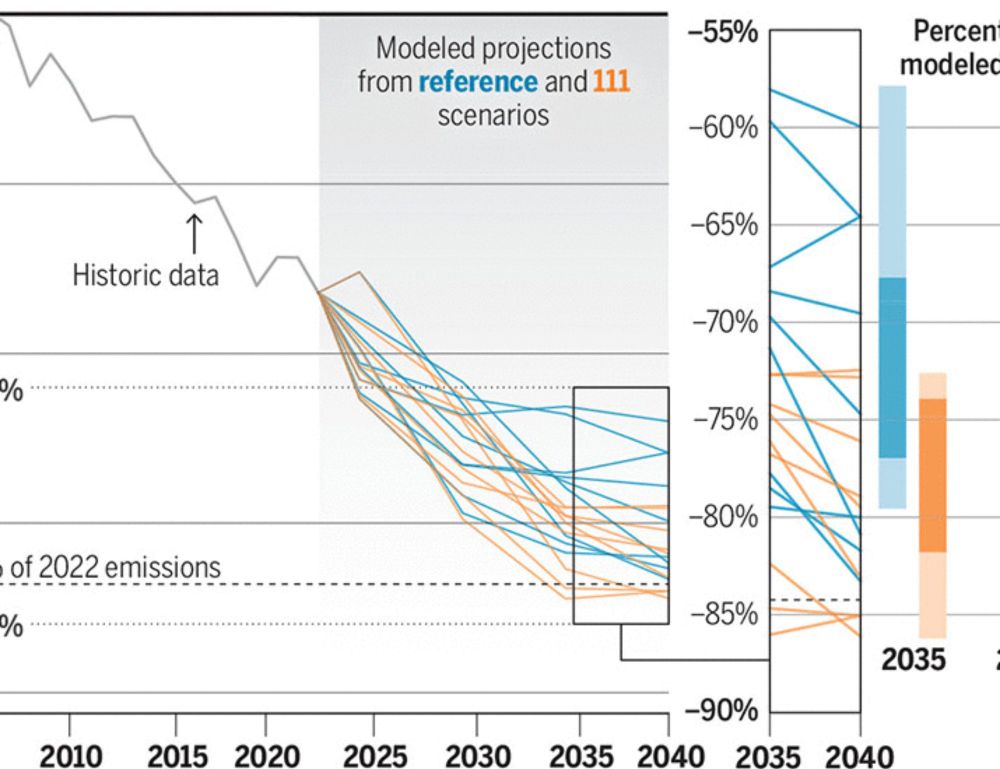
Impacts of EPA’s finalized power plant greenhouse gas standards
Emissions reductions may be met with relatively small costs
Read the full paper here: www.science.org/doi/10.1126/science.adt5665
Thanks to my stellar coauthors on this collaborative effort!
@aafawcett.bsky.social @jessedjenkins.com @nicholasroy.me @aliciaszhao.bsky.social @rff.org @ctrglobsust.bsky.social @nrdc.org @andlingercenter.bsky.social
09.01.2025 20:52 — 👍 6 🔁 2 💬 1 📌 0
He’s talking about a different sort of aerosols - small particles in the atmosphere (such as formed by sulfur dioxide emissions ) that reflect sunlight back into space.
08.01.2025 13:49 — 👍 2 🔁 0 💬 1 📌 0
Wow!
05.01.2025 22:40 — 👍 2 🔁 0 💬 1 📌 0
Congratulations to Phil Jones, climatologist at UEA’s Climatic Research Unit, on being awarded an OBE for his services to climatology
30.12.2024 22:43 — 👍 34 🔁 9 💬 3 📌 2
Note that, particularly for industrial (not power plant) sources, the emission height will vary even more widely - from substantial emissions at the surface to emissions from some sources that loft higher than power plants. This will also vary by emission species.
10.12.2024 03:45 — 👍 0 🔁 0 💬 0 📌 0
The community needs to consider how emission height information should be provided to modelers.
10.12.2024 03:45 — 👍 0 🔁 0 💬 1 📌 0
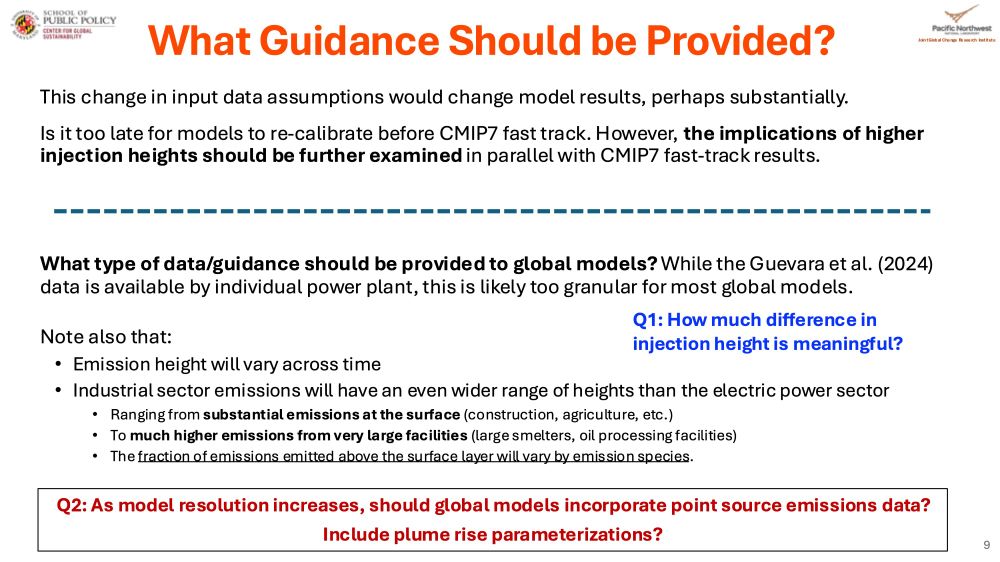
Slide discusses what type of guidance should be provided to modelers
While models can't incorporate this new information in time for CMIP7 fast track simulations, the implications of this new information should be evaluated in parallel.
10.12.2024 03:45 — 👍 1 🔁 0 💬 2 📌 0
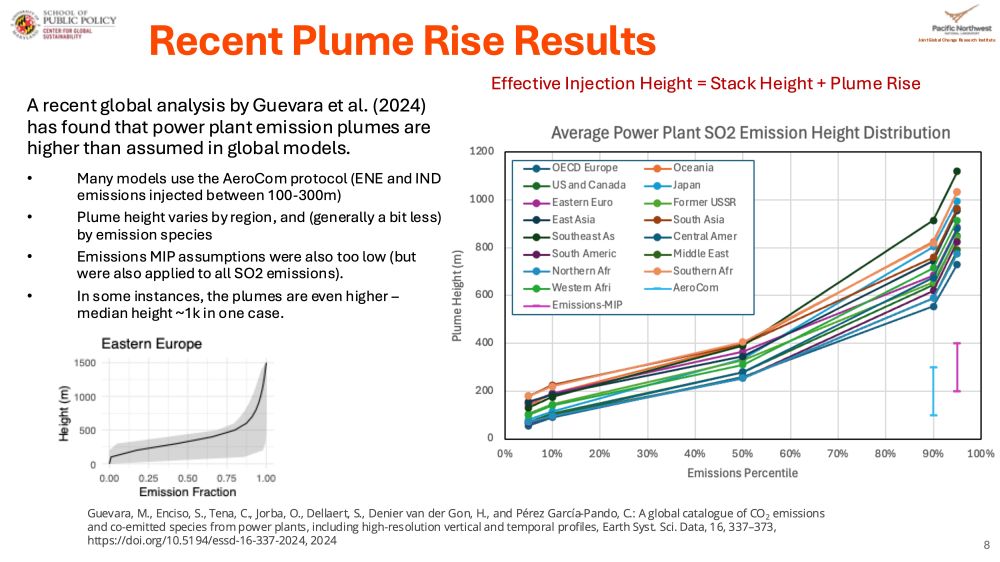
Slide shows regionally averaged results from Guevara et al.
While the weighted average regional height distribution varies somewhat by region, the emissions height is higher than the AeroCOM assumptions used by many modelers.
10.12.2024 03:45 — 👍 0 🔁 0 💬 1 📌 0
Last part of my #AGU24 talk on model assumptions for effective injection height (stack height plus plume rise). Assuming emissions are injected into the model surface layer will bias results, sometimes substantially.
10.12.2024 03:45 — 👍 4 🔁 0 💬 1 📌 0

Slide describes the reasons that the most recent emission estimates are particularly uncertain.
While we will release data out to 2023 in January, the last 1-2 years of this data, in particular, contain many assumptions and approximations. This means these values are more likely to change in future releases.A
10.12.2024 03:35 — 👍 0 🔁 0 💬 0 📌 0
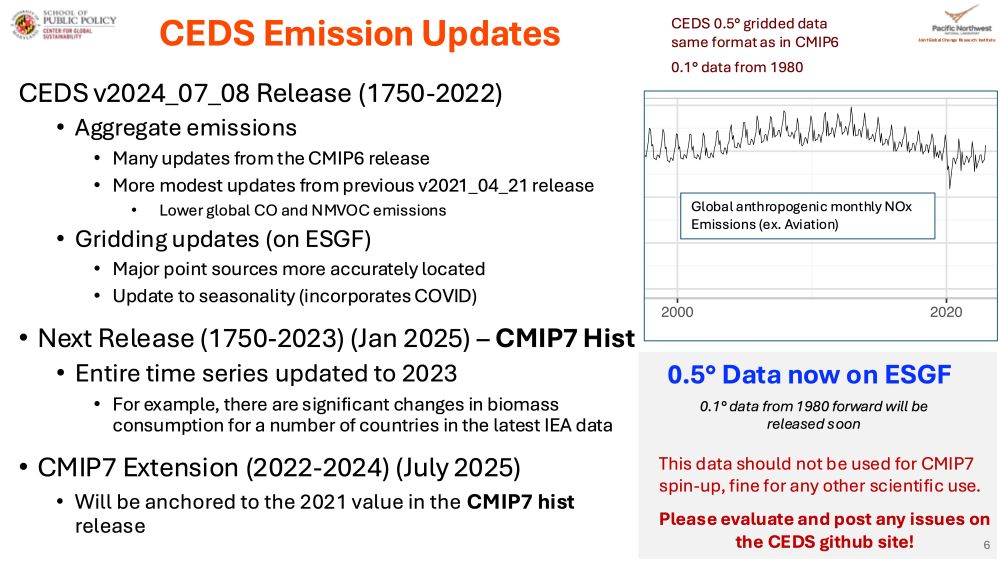
Slide describes current and future CEDS air pollutant (e.g. SLCF) emissions data
Emissions out to 2022 are now available for evaluation and testing. CMIP7 historical emissions will be released in Jan 2025. Extension from 2021 through 2024 released in July 2025 as part of future scenario data.
10.12.2024 03:35 — 👍 0 🔁 0 💬 1 📌 0
Atmospheric Scientist | Retired NASA Atmospheric Composition Modeling & Analysis Program (ACMAP) Manager | Yorktown, VA | 🇺🇦 | (He/Him)
Dad of two. Earth, climate, and planetary science reporter @Science.org magazine. Mistrusts narratives; still writes them.
https://www.science.org/content/author/paul-voosen
https://sciencemastodon.com/@voooos
voosen@protonmail.com
Signal: @voosen.01
Official daily update on atmospheric CO2 levels in the post-400 ppm era from Scripps Institution of Oceanography's iconic Keeling Curve.
Formerly Biden 46 and Obama 44.
Most recently Director of Implementation for the U.S. Environmental Protection Agency
Filipino-American (paleo)climate scientist and biogeochemist. Working on weathering, carbon, lithium, water, lakes, caves and soils. Assistant Professor at Brown University. https://sites.brown.edu/ibarra-lab/
climate scientist
posts 100% my own
🇨🇦 is my home
distinguished professor & chair, Texas Tech
chief scientist, The Nature Conservancy
board member, Smithsonian NMNH
alum, UToronto and UIUC
author, Saving Us
Climate scientist focusing on health risks, adaptation, mitigation, co-benefits, scenarios
Cutting-edge research, news, commentary, and visuals from the Science family of journals. https://www.science.org
Columbia Law School & Columbia Climate School's Sabin Center for Climate Change Law develops legal tools to combat the climate crisis: https://climate.law.columbia.edu/
Climate, water, birds, bluegrass mandolin. Member US National Academy of Sciences, MacArthur Fellow, Carl Sagan Prize, author of The Three Ages of Water (2023). Also on Mastodon. @petergleick@fediscience.org. Email me at pgleick (at) gmail.
Professor of climate + energy policy at UCSB. Alumni of MIT, Columbia and UToronto. Hosts "A Matter of Degrees" podcast. Cuts carbon pollution! Proudly 🇨🇦 Gardener 🌱 leahstokes.com
"A tireless chronicler and commentator on all things climate" -NYTimes.
Climate research lead @stripe, writer @CarbonBrief, scientist @BerkeleyEarth, IPCC/NCA5 author.
Substack: https://theclimatebrink.substack.com/
Twitter: @hausfath
I'm the Director of NCEI, and work with amazing people, but this is my personal account. Climate. Data. Risk. Okie stuff. Asheville stuff. Sugar by the bushel; molasses by the ton. Skipping leg day since 1998.
Pulitzer prize winning Editorial Cartoonist
Open Windows at http://anntelnaes.substack.com
Archived work at http://anntelnaes.com
understander of things climate-related, and some other things
@thepolycrisis.bsky.social
Climate scientist at the Met Office. I build climate services.
Semi-retired computer scientist, ancient UNIXer, "Big Data"
https://en.wikipedia.org/wiki/John_Mashey
Last 20 yrs: chasing anti-science disinfo, esp. on climate or tobacco, helping defend scientists.
Supporter of UCSF, CSLDF, NCSE, CSI, member AAAS, AGU.
Climate variability and change | Professor of Climate Science & Director of Climatic Research Unit | UEA | Views expressed here are my own, not UEA's
Washington Post climate advice columnist. Bring data. https://www.washingtonpost.com/people/michael-coren/


